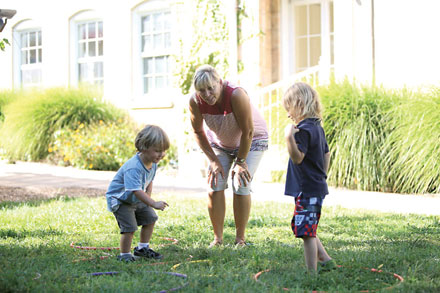
Every parent remembers the first time they dropped their child off at school. There’s anticipation and excitement, but also nervousness. “How will they do without me? Will they cry? For how long? Do I just leave, or stay a while and help them settle down?” So many questions, and so many different possible answers.
At Maharishi Preschool in Fairfield, teachers are ready to help children and parents transition to their new school routine by using the Montessori Method. This loving yet authoritative philosophy was developed by Dr. Maria Montessori over 100 years ago, and since that time it has been used to cultivate emotional intelligence and academic proficiency in children from many different cultures.
The foundation of the Montessori Method is the creation of a safe, secure feeling for children in the classroom. “One of the most important things for all children is the sense of belonging and significance,” says lead preschool teacher Rebecca Bellonci.
This feeling of inclusion starts the moment kids arrive on their first day of school, when teachers individually acknowledge each child. “Greeting is a very big part of our morning,” says Bellonci. “We want to connect emotionally to the children, so all the teachers are building their relationship with each child and interacting with them on the playground and in the classroom.”
If a preschooler cries when they are dropped off to school for the first time—and many do—teachers are ready to offer comfort and reassurance. This is done in a way that not only helps children to calm down and enjoy their morning, but also teaches them to identify and work with their emotions in a constructive way.
The teachers begin by helping the student identify their emotions. Preschoolers often don’t have the vocabulary to express exactly how they’re feeling, and without the correct language to ask for help, frustration can mount even higher. Rather than immediately soothing children with phrases like, “it’s ok” or “everything’s fine,” preschool staff emphasize the importance of emotional honesty. “We want to honor the feeling of the child, so we do a lot of reflective observations to help them name their emotions,” Bellonci explains. “We might say, ‘You look upset’ or ‘You look sad.’ The child actually feels comfortable when you are acknowledging the true feeling that they have.”
Once the child has identified their mood, teachers work to help them regroup. A teacher might ask, “What would help you?” or “What would you like to do?”
Sometimes a child’s chosen outlet is an expression of anger, and that’s okay, too. Bellonci explains, “Kids learn that these feelings are okay—the teachers are not intimidated in any way by their feelings.”
These lessons in emotional intelligence lay the groundwork for a lifetime of successful interactions. Bellonci explains, “We’re helping the children understand how they can recover from the emotional state they’re in. If they become overwhelmed with emotion and they’re upset about something, we offer them tools for how they can recover from it.”

The teachers use routine to convey a sense of stability for their young students.
The preschool teachers also use routine to convey a sense of stability and predictability. The children learn that their school is a safe, solid place where they know what is coming next, and can enjoy each activity in sequence. According to Bellonci, “Establishing a routine for a child is really important. The toddlers especially enjoy it.” As the children move through their schedule of play, snack time, and activities, they begin to feel secure about what is happening at each stage of the morning.
If a student gets homesick, Bellonci reminds them of the routine. “Mama loves you, and Mama brought you here to play. You came to play with friends, so we’ll play with friends, then we’ll go inside, and then we’ll come outside, and then we’ll go home.”
During the first two weeks of school, Bellonci and her team of teachers ease new students into classroom life, and make sure that no child is upset for very long. “The first couple days I had a few children go home early,” she says. “They just were learning their mom comes back. Other children cried just a little bit and then they settled into the routine the first week.”
By acclimating students to the school routine and teaching them to identify and manage their own feelings and needs, the preschool teachers help children get the most out of their time in the classroom. Bellonci loves the transition her students make when they arrive at school and understand all the possibilities that await them. “It’s an incredibly enriching place for the youngest child to have, to go each day and really start to embody the lifelong love of learning.” she says.
“It’s such a long period of a child’s life that they’re going to school,” Bellonci explains, “so the biggest thing that I want to instill in the Maharishi Preschool students is that school meets my needs, and I love going to school.”
